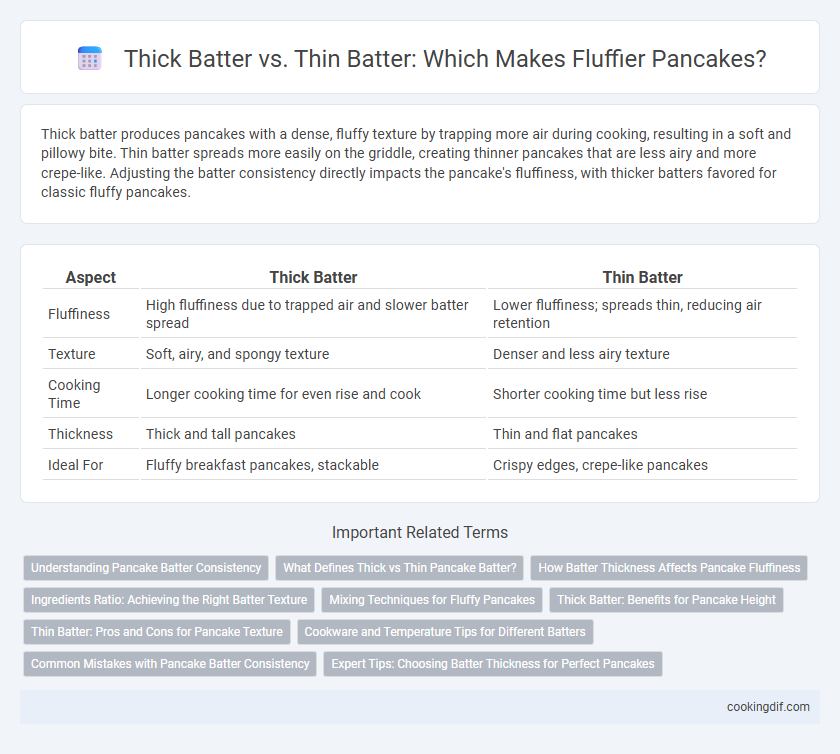Thick batter produces pancakes with a dense, fluffy texture by trapping more air during cooking, resulting in a soft and pillowy bite. Thin batter spreads more easily on the griddle, creating thinner pancakes that are less airy and more crepe-like. Adjusting the batter consistency directly impacts the pancake's fluffiness, with thicker batters favored for classic fluffy pancakes.
Table of Comparison
| Aspect | Thick Batter | Thin Batter |
|---|---|---|
| Fluffiness | High fluffiness due to trapped air and slower batter spread | Lower fluffiness; spreads thin, reducing air retention |
| Texture | Soft, airy, and spongy texture | Denser and less airy texture |
| Cooking Time | Longer cooking time for even rise and cook | Shorter cooking time but less rise |
| Thickness | Thick and tall pancakes | Thin and flat pancakes |
| Ideal For | Fluffy breakfast pancakes, stackable | Crispy edges, crepe-like pancakes |
Understanding Pancake Batter Consistency
Thick pancake batter retains more air bubbles during cooking, resulting in a fluffier texture and higher rise due to its higher viscosity and reduced spread. Thin batter spreads quickly on the griddle, producing thinner, denser pancakes with less lift. Understanding the balance between flour-to-liquid ratio and mixing technique is essential for achieving the desired pancake fluffiness and consistency.
What Defines Thick vs Thin Pancake Batter?
Thick pancake batter contains a higher ratio of flour to liquid, resulting in a dense consistency that traps air bubbles and produces fluffy, thick pancakes. Thin batter has more liquid relative to flour, spreading easily on the griddle but yielding thinner, less airy pancakes. The balance of flour, milk, eggs, and leavening agents like baking powder defines the batter's thickness and directly influences pancake texture.
How Batter Thickness Affects Pancake Fluffiness
Thick batter traps more air bubbles, resulting in pancakes with a fluffier and more tender texture. Thin batter spreads quickly on the griddle, producing thinner and denser pancakes with less rise. Optimal pancake fluffiness is achieved by balancing batter viscosity to maintain air pockets while allowing even cooking.
Ingredients Ratio: Achieving the Right Batter Texture
Thick batter with a higher ratio of flour to liquid produces dense, fluffy pancakes by trapping more air during cooking, while thin batter results in thinner, less airy pancakes due to decreased structure. Ideal ingredient ratios generally favor a balance of about 1 cup of flour to 3/4 cup of milk to maintain optimal batter thickness for fluffiness. Incorporating precise leavening agents like baking powder and controlling liquid content ensures the batter rises properly, enhancing pancake texture and height.
Mixing Techniques for Fluffy Pancakes
Thick batter retains more air bubbles during mixing, leading to a fluffier pancake texture, while thin batter spreads more easily but yields denser results. Gentle folding techniques, such as carefully incorporating wet ingredients into dry without overmixing, preserve the batter's aeration and prevent gluten overdevelopment. Resting the thick batter for a few minutes before cooking allows trapped air to expand, further enhancing pancake fluffiness.
Thick Batter: Benefits for Pancake Height
Thick batter produces pancakes with greater height and a fluffy interior due to its higher starch and protein concentration, which traps more air during cooking. This dense consistency allows pancakes to rise more effectively, creating a soft and tender texture. The increased viscosity also slows spreading on the griddle, resulting in thicker, more visually appealing pancakes.
Thin Batter: Pros and Cons for Pancake Texture
Thin batter results in lighter, more delicate pancakes with a tender crumb and slightly crisp edges, ideal for those preferring a less dense texture. However, thin batter pancakes can be fragile and may tear easily during flipping, requiring careful cooking. This consistency allows for more even cooking and quicker preparation but may lack the rich, fluffy volume achieved by thicker batters.
Cookware and Temperature Tips for Different Batters
Thick batter requires a non-stick skillet heated over medium-low to medium temperature to ensure even cooking without burning the exterior, producing fluffy pancakes with a tender interior. Thin batter cooks best on a lightly greased griddle set to medium-high heat, allowing the batter to spread evenly and form a golden, crisp edge. Using a cast iron pan enhances heat retention for thick batter, while a flat electric griddle offers consistent temperature control ideal for thin batter pancakes.
Common Mistakes with Pancake Batter Consistency
Thick batter often leads to dense pancakes because it limits the batter's ability to spread and incorporate air, reducing fluffiness. Thin batter can cause pancakes to spread too much and become flat, losing their soft, airy texture. A balanced batter, moderately thick and smooth, traps bubbles efficiently and results in the ideal fluffy pancake texture.
Expert Tips: Choosing Batter Thickness for Perfect Pancakes
Thick batter creates pancakes with a denser, fluffier texture due to its higher viscosity, which traps more air during cooking, while thin batter spreads easily but yields thinner, less airy pancakes. Experts recommend adjusting the flour-to-liquid ratio to achieve the desired batter thickness, typically a ratio close to 2:1 for thick batter and 1:1 for thin batter. Incorporating ingredients like baking powder and allowing the batter to rest enhances fluffiness regardless of thickness, optimizing pancake quality.
Thick batter vs thin batter for pancake fluffiness Infographic

 cookingdif.com
cookingdif.com